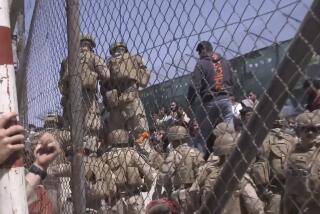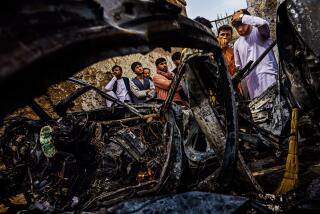Attack on convoy in Afghanistan leaves 5 Americans dead
- Share via
KABUL, Afghanistan — On the day that Joint Chiefs of Staff Chairman Gen. Martin Dempsey arrived in Afghanistan for an assessment visit, six Americans were killed Saturday in attacks by insurgents.
Hours after Dempsey arrived, five Americans — three soldiers and two civilians — were killed when a bomb-laden vehicle exploded in Zabol province in the southeast. An Afghan doctor was also killed in the attack.
Another American was killed in an insurgent attack in eastern Afghanistan, military officials said. The one-day American death toll was the highest since last summer.
The bloodshed was condemned by U.S. Secretary of State John F. Kerry, who said the victims included “an exceptional young Foreign Service officer,” a woman whose name was not immediately released.
“Just last week in Kabul,” Kerry said, “I met our fallen officer when she was selected to support me during my visit to Afghanistan. She was everything a Foreign Service officer should be: smart, capable, eager to serve and deeply committed to our country and the difference she was making for the Afghan people.”
Kerry said the convoy, including U.S. officials and Afghan colleagues, was on its way to donate books to students in the provincial capital when the attack took place.
Dempsey is in Afghanistan for a weekend visit aimed at assessing the amount and type of training that U.S. troops will continue to provide Afghan defense forces after 2014, military officials said.
Saturday’s violence follows an insurgent strategy of attacking foreign troops to persuade them to hasten their departure, analysts said, as well as targeting symbols of the Afghan state to discredit it.
Dempsey, who arrived at Bagram air base after an overnight flight, was scheduled to meet with U.S. allied commanders, Afghan officials and soldiers in the field, said John Manley, deputy spokesman with the U.S.-led International Security Assistance Force, or ISAF. Dempsey was last in Afghanistan in February for a change-of-command ceremony.
America’s top military commander told reporters his assessment would help shape U.S. decisions about how many American troops should remain after the U.S. and NATO combat role ends next year, according to the Associated Press.
There are 100,000 coalition troops in Afghanistan, according to ISAF, 68,000 of them Americans. Dempsey told reporters Friday in Stuttgart, Germany, that he would probably decide this summer the ideal size of the U.S. force beyond 2014 after seeing how much progress Afghan forces had made.
ISAF has put significant focus on training Afghan troops in preparation for drastically reducing its role, but has had mixed success. The sharp rise in attacks on foreign troops by gunmen in Afghan military uniforms, whether by genuine soldiers or insurgents using uniforms as cover, has increased distrust between the allies.
Last year, reflecting its growing concern, the Defense Department issued two decrees on how to interact with Afghan soldiers. One states that all U.S. soldiers serving in Afghanistan should be alert and carry a loaded magazine at all times along with their weapon. The other said that at least one U.S. soldier should stand guard apart from the rest, with his or her weapon ready, whenever American soldiers are on duty in the presence of Afghan forces.
Other problems affecting the Afghan army include desertion, corruption, illiteracy and morale, analysts said. However, recruiting has become easier in recent months, some said, as a reduction in foreign troops and humanitarian groups exacerbates unemployment and weakens the local economy.
“Many more people are joining the police or army because there are so few jobs,” said Hamid, 36, a struggling shopkeeper wearing a brown hat and traditional shalwar kameez outfit on the periphery of Bagram, who uses only one name. “Now even young people are joining, even though it’s dangerous work.”
Afghan troops and police lack much of the high-technology equipment their foreign counterparts have, including bomb-resistant vehicles, night-vision equipment and ground-piercing radar to counter roadside bombs. They do, however, understand the terrain, social context and tribal links to which foreign troops are often oblivious.
As Washington and Kabul hash out how many foreign troops will remain and in what capacity, a lot will depend on how they are used, some said.
“For training and advising the Afghan security forces, even 15,000 is a lot,” said Atiqullah Amarkhail, a Kabul-based military analyst. “But if they’re fighting shoulder to shoulder with Afghan troops, there should be at least 40,000 U.S. troops remaining here.”
Amarkhail said past training programs were inadequate and Afghan troops hadn’t had enough practice using high-technology equipment. Afghan commanders are making progress, he said, but intelligence gathering remains weak, which means that most Afghan units still aren’t strong enough to win a battle against insurgents without the support of foreign troops.
Times staff writer Richard A. Serrano in Washington and special correspondent Hashmat Baktash in Kabul contributed to this report.
More to Read
Sign up for Essential California
The most important California stories and recommendations in your inbox every morning.
You may occasionally receive promotional content from the Los Angeles Times.










